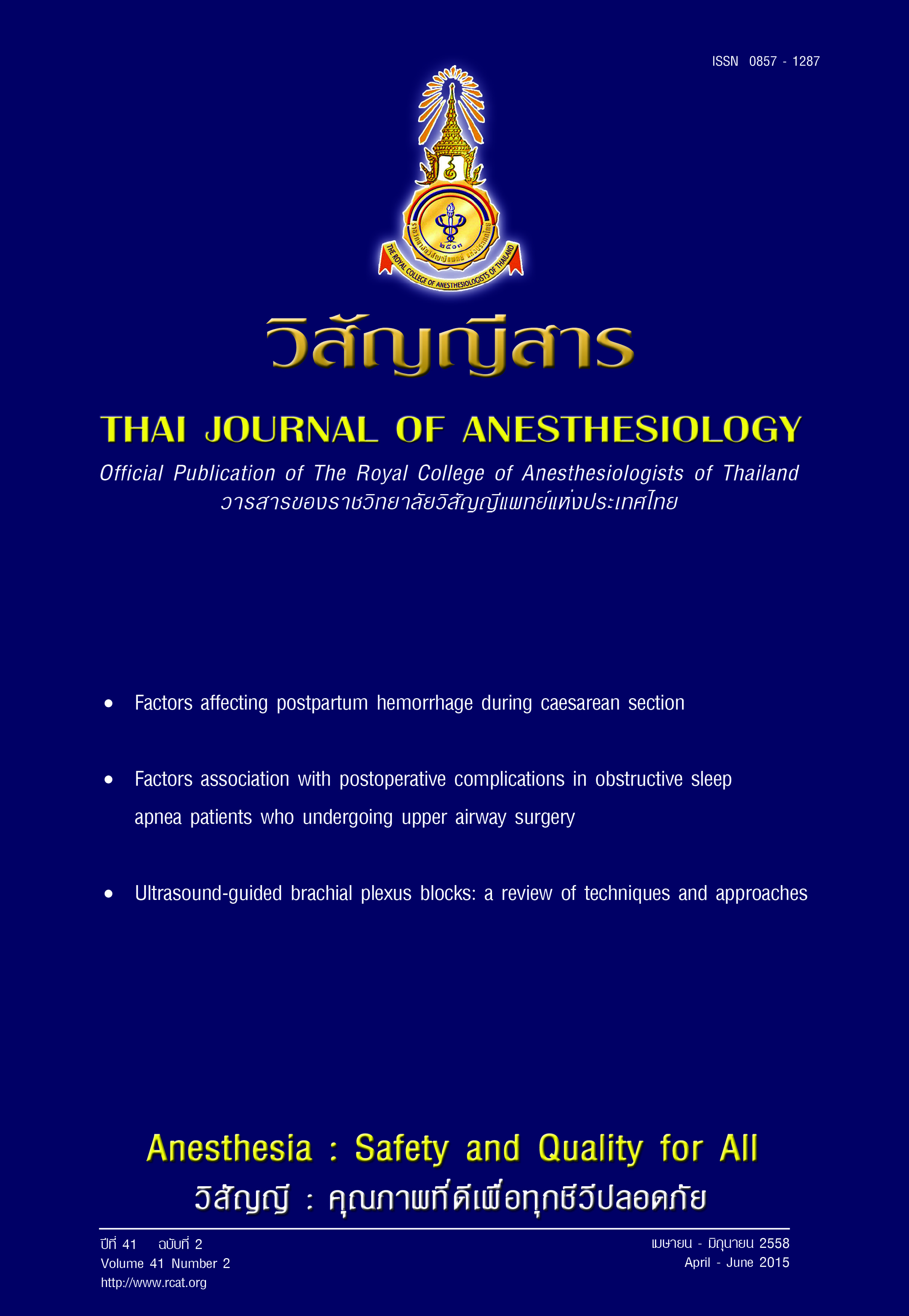Factors affecting postpartum hemorrhage during caesarean section
Main Article Content
Abstract
Background: Postpartum hemorrhage (PPH) remains the leading cause of maternal morbidity and mortality worldwide, especially in the developing countries. The use of general anesthesia or regional anesthesia has been performed in caesarean delivery. Therefore, PPH problem might occur toward maternal morbidity and mortality if the obstetric anesthetists did not provide an effective and optimum care to the parturients. The adverse event such as death due to PPH would not be accepted for their family and relatives. Consequently, medical expenses and suing will be increased.
Objective: To determine factors affecting early postpartum hemorrhage in caesarean delivery.
Methods: This retrospective study was designed to investigate the factors affectingpostpartum hemorrhage in 1,361 obstetric patients, who had been documented of caesarean section, both elective and emergency, at Faculty of Medicine, Ramathibodi Hospital, Mahidol University, Bangkok Thailand. The data were collected from the anesthesia and operative record forms documented from May 2011 to May 2012.
Definition: Postpartum hemorrhage (PPH) is defined as the situation when a patient has excessive blood loss of more than 1,000 ml, undergoes B-lynch procedure or receives blood transfusion following caesarean section.
Results: The incidence of PPH cases in caesarean section at Ramathibodi Hospital was 4.78%. The caesarean section under general anesthesia (p < 0.001) and infant weight of more than 3600 gm (p < 0.007) were the statistically significant factors associated with early PPH. Maternal age, weight ,height, hematocrit, parity, preeclampsia, twin or multiple gestation , breech presentation, the surgeon (medical staff or resident) who did the caesarean section were not significantly associated with early PPH .
Conclusion: It is vitally important that the anesthetists should be watchful for early postpartum in caesarean section under general anesthesia and/or with big infant.
ปัจจัยที่สัมพันธ์กับการตกเลือดในการผ่าตัดคลอดทางหน้าท้อง
บทนำ: ภาวะตกเลือดหลังคลอดเป็นภาวะวิกฤตของหญิงตั้งครรภ์ เนื่องจากเป็นสาเหตุการตายอันดับแรกของหญิงตั้งครรภ์ทั่วโลกโดยเฉพาะประเทศที่กำลังพัฒนา จึงจำเป็นต้องให้ความสำคัญต่อภาวะตกเลือดหลังคลอด โดยเฉพาะภาวะตกเลือดหลังคลอดทันทีเป็นภาวะที่พบได้บ่อย มีการเสียเลือดจำนวนมาก และมีอัตราการตายสูง หากขาดการเฝ้าระวังและความพร้อมให้การช่วยเหลือทันที ปัจจุบันพบว่ามีการผ่าตัดคลอดทางหน้าท้องเพิ่มมากขึ้น ดังนั้นอาจพบภาวะตกเลือดหลังคลอดได้บ่อย หากขาดความพร้อมในการเฝ้าระวังอาจเสี่ยงต่อการเกิดภาวะแทรกซ้อนที่รุนแรงจนอาจเป็นอันตรายถึงแก่ชีวิตของหญิงตั้งครรภ์ ซึ่งบุคคลในครอบครัวไม่อาจยอมรับได้ รวมทั้งก่อให้เกิดค่าใช้จ่ายในการรักษาที่สูงขึ้นและการฟ้องร้องที่เพิ่มขึ้น
วัตถุประสงค์การวิจัย: เพื่อค้นหาปัจจัยทำนายภาวะตกเลือดขณะผ่าตัดคลอดทางหน้าท้องของหญิงตั้งครรภ์ที่มารับบริการในคณะแพทยศาสตร์โรงพยาบาลรามาธิบดี มหาวิทยาลัยมหิดล
วิธีวิจัย: การศึกษานี้เป็นการศึกษาข้อมูลย้อนหลัง โดยดูจากใบบันทึกการให้การระงับความรู้สึก และการผ่าตัดคลอดทางหน้าท้อง ในคณะแพทยศาสตร์ โรงพยาบาลรามาธิบดี มหาวิทยาลัยมหิดล ตั้งแต่เดือนพฤษภาคม พ.ศ. 2554 ถึงเดือนพฤษภาคม พ.ศ. 2555 จำนวน 1,361 ราย ทั้งแบบวางแผนล่วงหน้า (elective) และแบบฉุกเฉิน (emergency)
คำจำกัดความ: ภาวะตกเลือดหลังคลอดทันทีในการผ่าตัดคลอดทางหน้าท้องคือการสูญเสียเลือดตั้งแต่ 1,000 มิลลิลิตร หรือได้รับการผูกเย็บมดลูก (B-lynch procedure) และการได้รับเลือด
ผลการวิจัย: จากการศึกษาพบอุบัติการณ์ของการเกิดภาวะตกเลือดหลังคลอดทันทีในมารดาที่ได้รับการผ่าตัดคลอดทางหน้าท้อง ในโรงพยาบาลรามาธิบดี พบได้ร้อยละ 4.78 พบปัจจัยที่มีความสัมพันธ์กับภาวะตกเลือดหลังคลอดในการผ่าตัดคลอดทางหน้าท้องอย่างมีนัยสำคัญทางสถิติได้แก่ การได้รับยาระงับความรู้สึกแบบทั่วตัว (P < 0.001) และน้ำหนักทารกมากกว่า 3,600 กรัม (P < 0.007) ปัจจัยที่ไม่มีความสัมพันธ์กับภาวะตกเลือดหลังคลอดได้แก่ อายุ น้ำหนัก ส่วนสูงของมารดา ระดับความเข้มข้นของเม็ดเลือดแดง ลำดับที่ของการตั้งครรภ์ ลำดับที่ของการคลอด ตั้งครรภ์แฝด ครรภ์เป็นพิษ ทารกที่มีส่วนนำเป็นก้น แพทย์ผ่าตัด
สรุป: ประโยชน์ที่ได้จากการศึกษาใช้เป็นแนวทางแก่บุคลากรวิสัญญีผู้ดูแลต้องให้ความสำคัญเป็นพิเศษและเตรียมความพร้อมต่อภาวะตกเลือดหลังคลอดทันทีในการผ่าตัดคลอดทางหน้าท้อง ในหญิงตั้งครรภ์ที่ได้รับยาระงับความรู้สึกแบบทั่วตัวและทารกที่มีขนาดใหญ่


